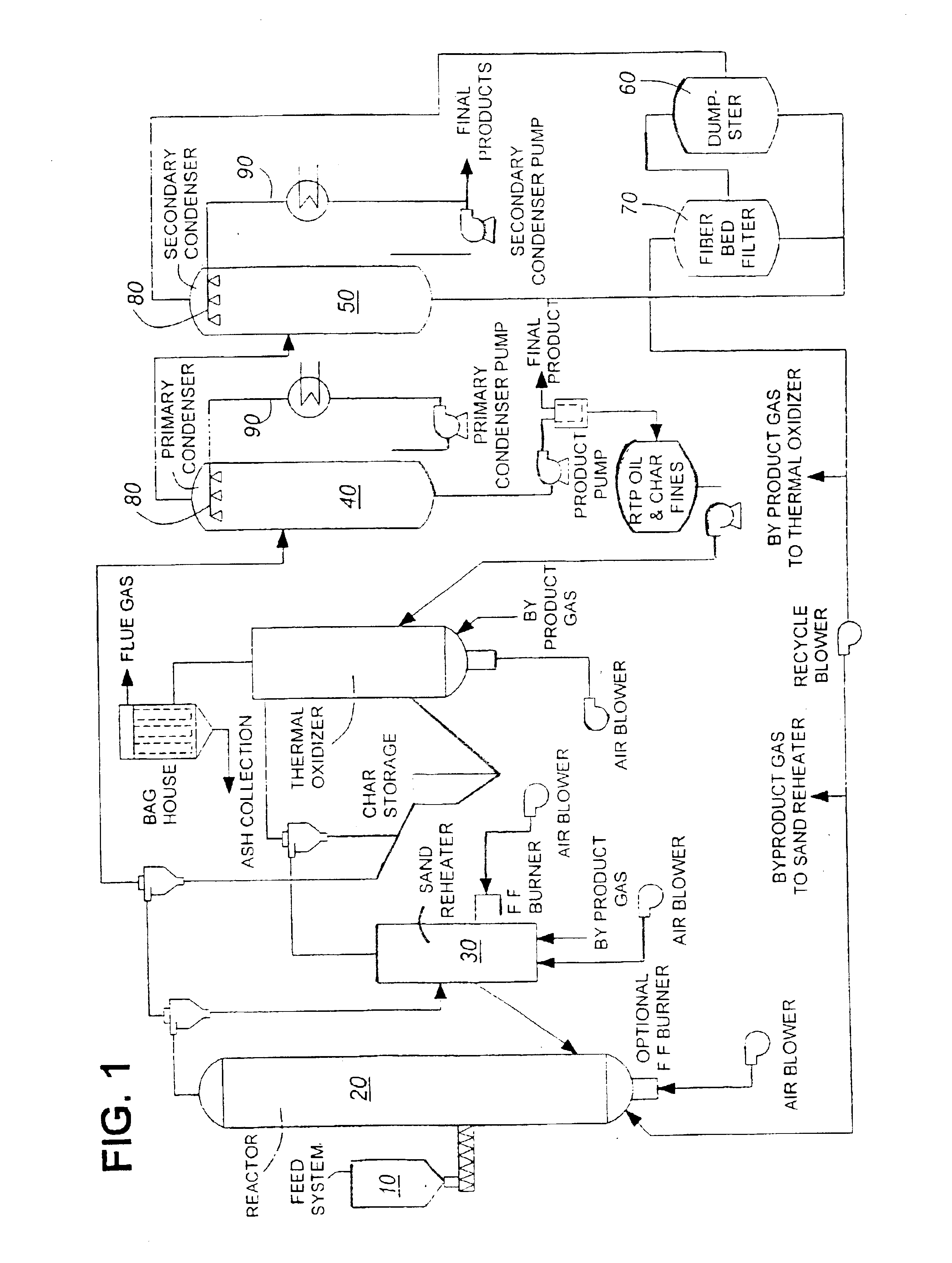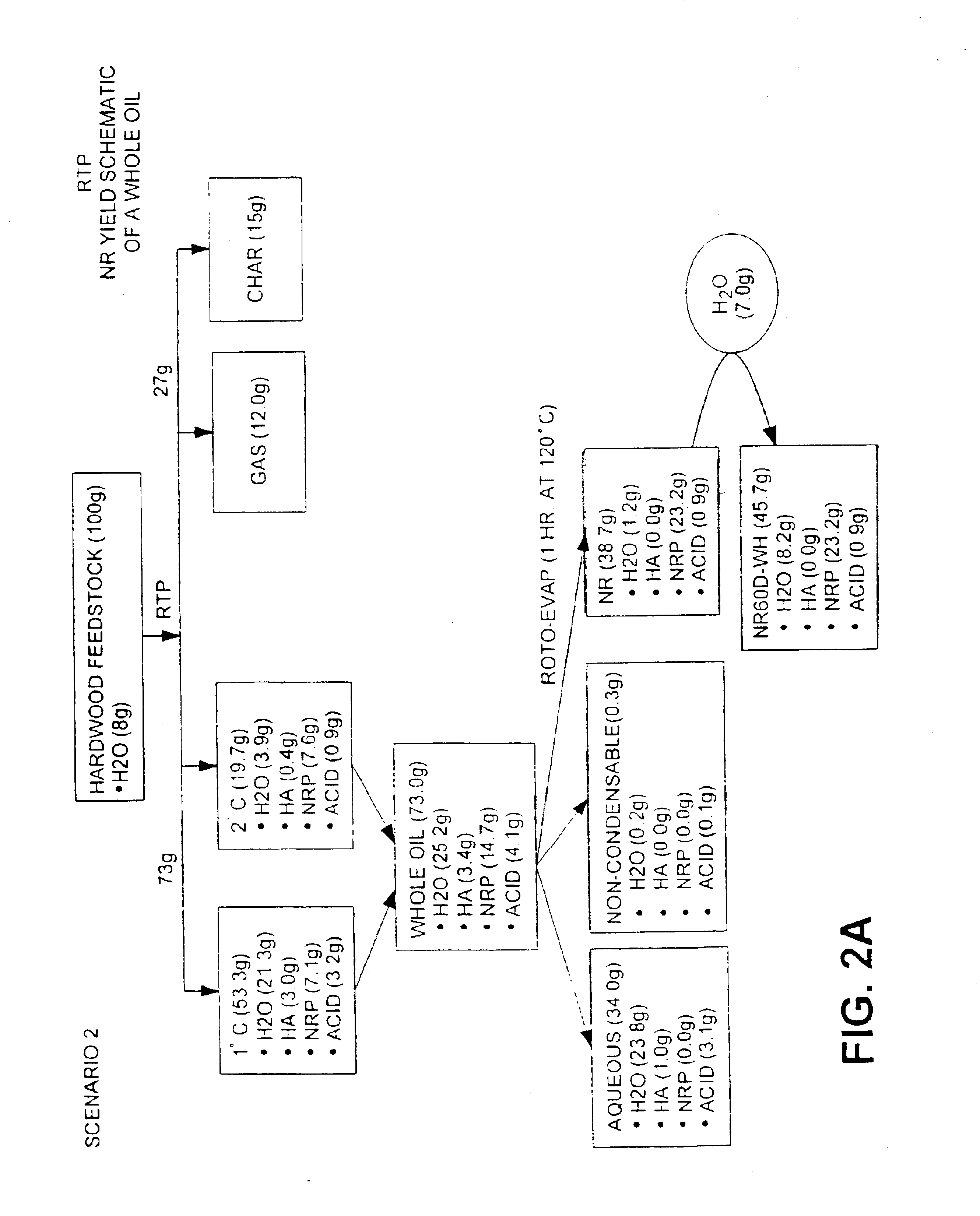Natural resin formulations
a technology of natural resin and formulation, applied in the direction of aldehyde/ketone condensation polymer adhesive, energy input, detergent composition, etc., can solve the problems of limiting the permeation of lignin-p/f resin into the wood, reducing shelf life, and increasing the cost of formaldehyde production, so as to improve the flowability of downstream equipment, enhance the removal of non-resin components, and reduce viscosity
- Summary
- Abstract
- Description
- Claims
- Application Information
AI Technical Summary
Benefits of technology
Problems solved by technology
Method used
Image
Examples
example 1
Method for Obtaining, and the Characteristics of, Oil Feedstocks
Oil feedstock is obtained using red maple feedstock within a fast pyrolysis reactor as described in WO 91 / 11499 (which is incorporated herein by reference). Red maple feedstock is supplied to the reactor at a feedstock to heat carrier ratio of from about 5:1 to about 200:1. The char is rapidly separated from the product vapour / gas stream, and the product vapour rapidly quenched within the primary recovery unit using, for example, a direct liquid contact condenser. The compounds remaining within the product vapour are transferred to a secondary recovery unit linked to the primary recovery unit in series. The product vapour is then quenched using, for example a direct-liquid contact condenser within the secondary recovery unit, and the condensed product collected. Any remaining product within the product vapour is collected within the demister and filter bed (see FIG. 1). The primary recovery unit product is collected, as...
example 2
Preparation and Analysis of Liquid NR, MNRP and V-additive Lignin
Liquid NR Production Using Rotoevaporation
Oil feedstocks from Example 1 are processed by distillation / evaporation at 120° C. for 1 hour under vacuum of 26″Hg to a water content of about 3% (wt %) to produce an NR. The product is removed and water is added to the liquid NR when the NR reaches a temperature of about 80° C. to make a final water content of 16-18 (wt %). The NR is mixed well and allowed to cool to room temperature.
Liquid NR is typically characterized by comprising a water content of from about 10 to about 20 wt %, pH of about 2.0 to about 5.0, an acids content from about 0.1 to about 5 (dry wt %), an average molecular weight (wet) / (dry) of from about (250-350) / (280-380) Daltons, and a viscosity of about 6 to about 130 cST (@70° C.). Analysis of liquid NR is presented in Tables 2 and 3 below.
Solid MNRP Production Using Rotoevaporation
Oil feedstocks from Example 1 are processed by distillation / evaporation at...
example 3
Replacement of Phenol within NR-containing PF Resins and Their Use in OSB Manufacture
The NR produced according to the method of Example 2 is formulated into a resin according to industry standards except that 40% of the phenol content is replaced by the NR. The adhesive resin comprised a formaldehyde:(phenol+NR) ratio of 1.6:1. An adhesive prepared from a Bio-oil-WH (i.e. the whole-oil feedstock), that had not been processed by distillation / evaporation is included for comparison.
Typical NR resin formulations involved loading phenol, water and paraformaldehyde into a kettle and heating to 95° C. to dissolve the paraformaldehyde. The mixture is cooled to 45° C. and the NR added. Caustic (NaOH) is then added to the desired pH thereby solubilizing the NR and initiating the reaction. During the addition of caustic, the mixture is maintained at 45° C. for the first caustic addition (approximately ⅔ of the amount required). The mixture is then slowly heated to 90° C. over a 30 min period o...
PUM
| Property | Measurement | Unit |
|---|---|---|
| Temperature | aaaaa | aaaaa |
| Fraction | aaaaa | aaaaa |
| Fraction | aaaaa | aaaaa |
Abstract
Description
Claims
Application Information
 Login to View More
Login to View More - R&D
- Intellectual Property
- Life Sciences
- Materials
- Tech Scout
- Unparalleled Data Quality
- Higher Quality Content
- 60% Fewer Hallucinations
Browse by: Latest US Patents, China's latest patents, Technical Efficacy Thesaurus, Application Domain, Technology Topic, Popular Technical Reports.
© 2025 PatSnap. All rights reserved.Legal|Privacy policy|Modern Slavery Act Transparency Statement|Sitemap|About US| Contact US: help@patsnap.com



